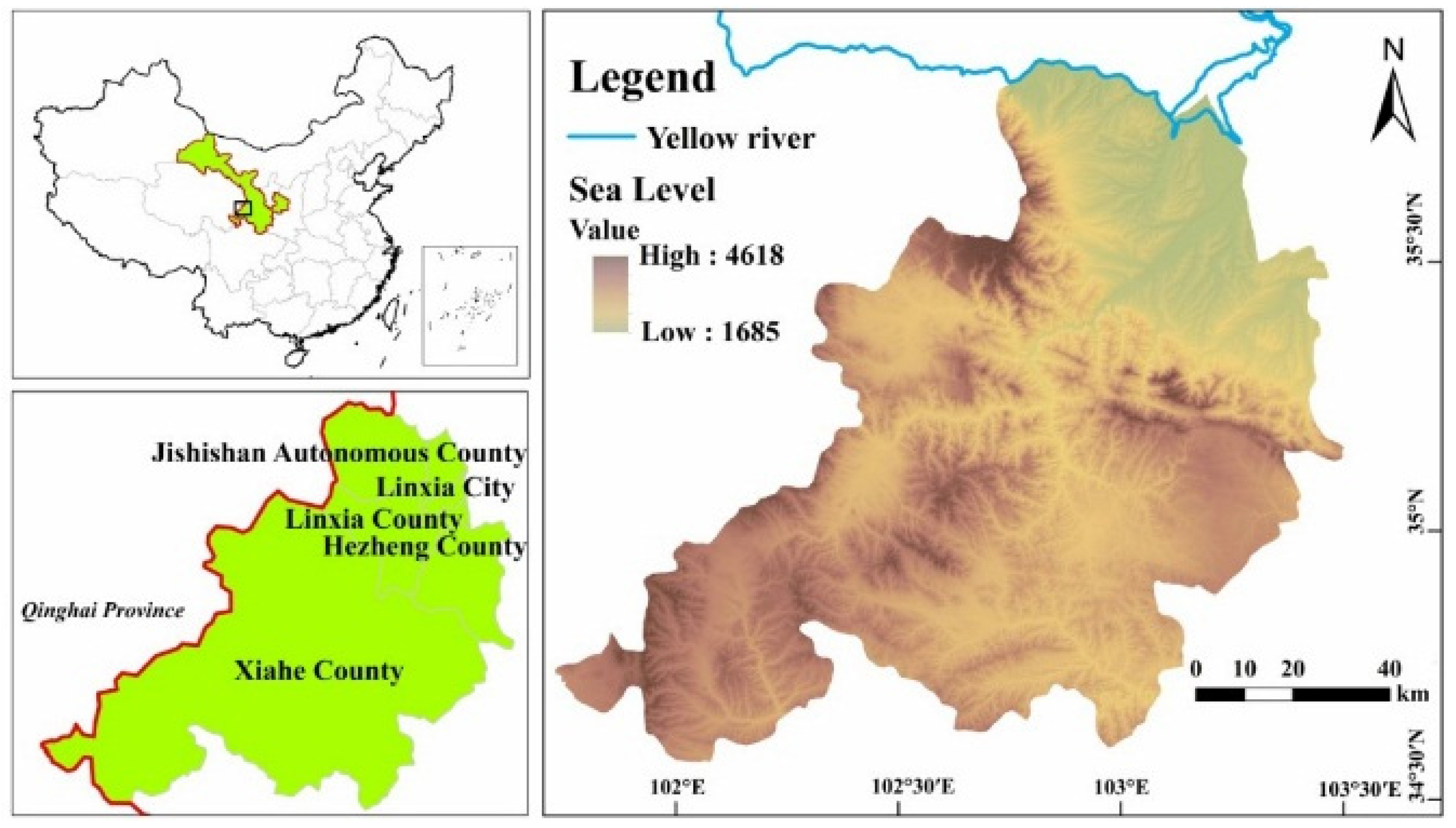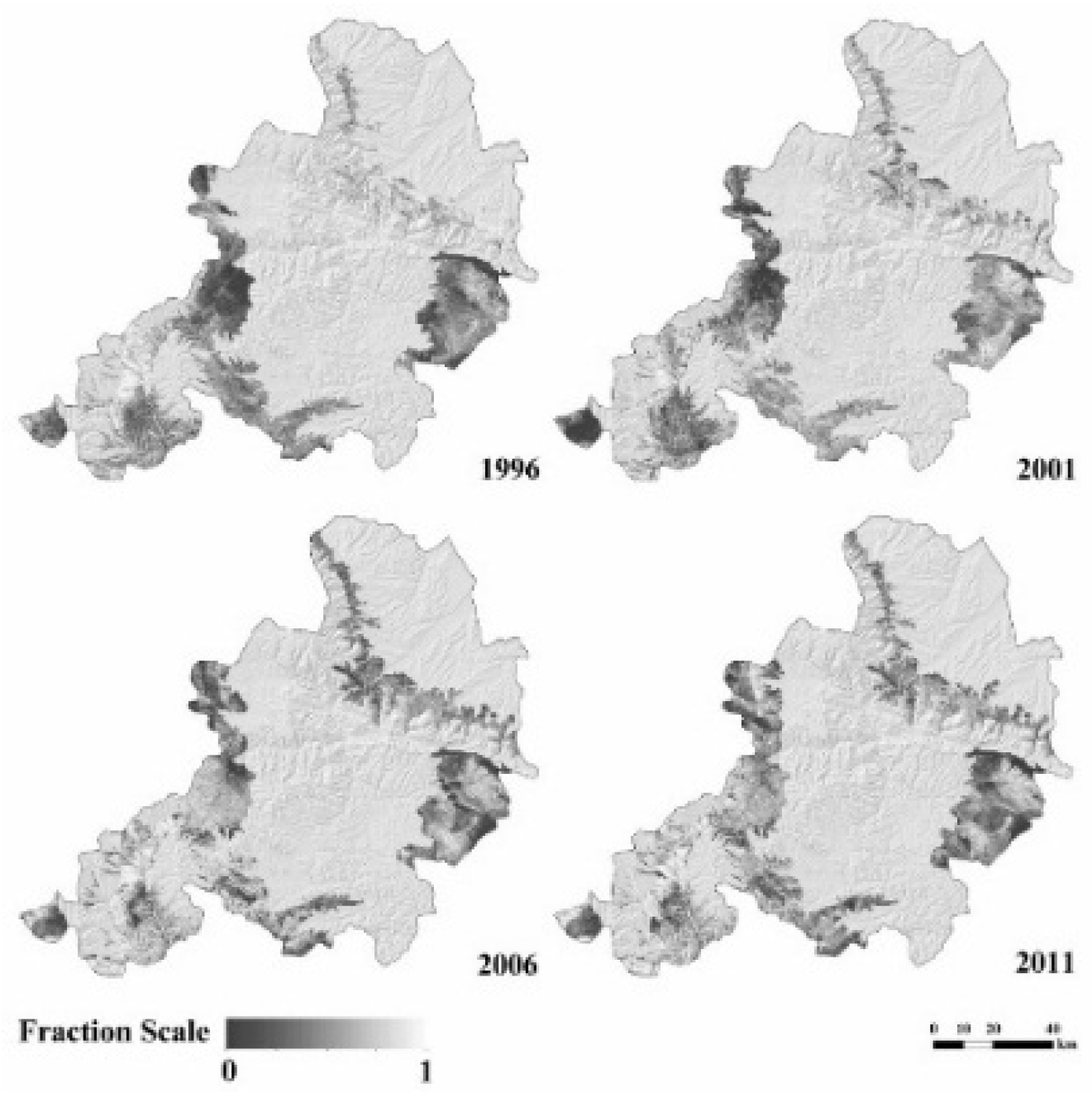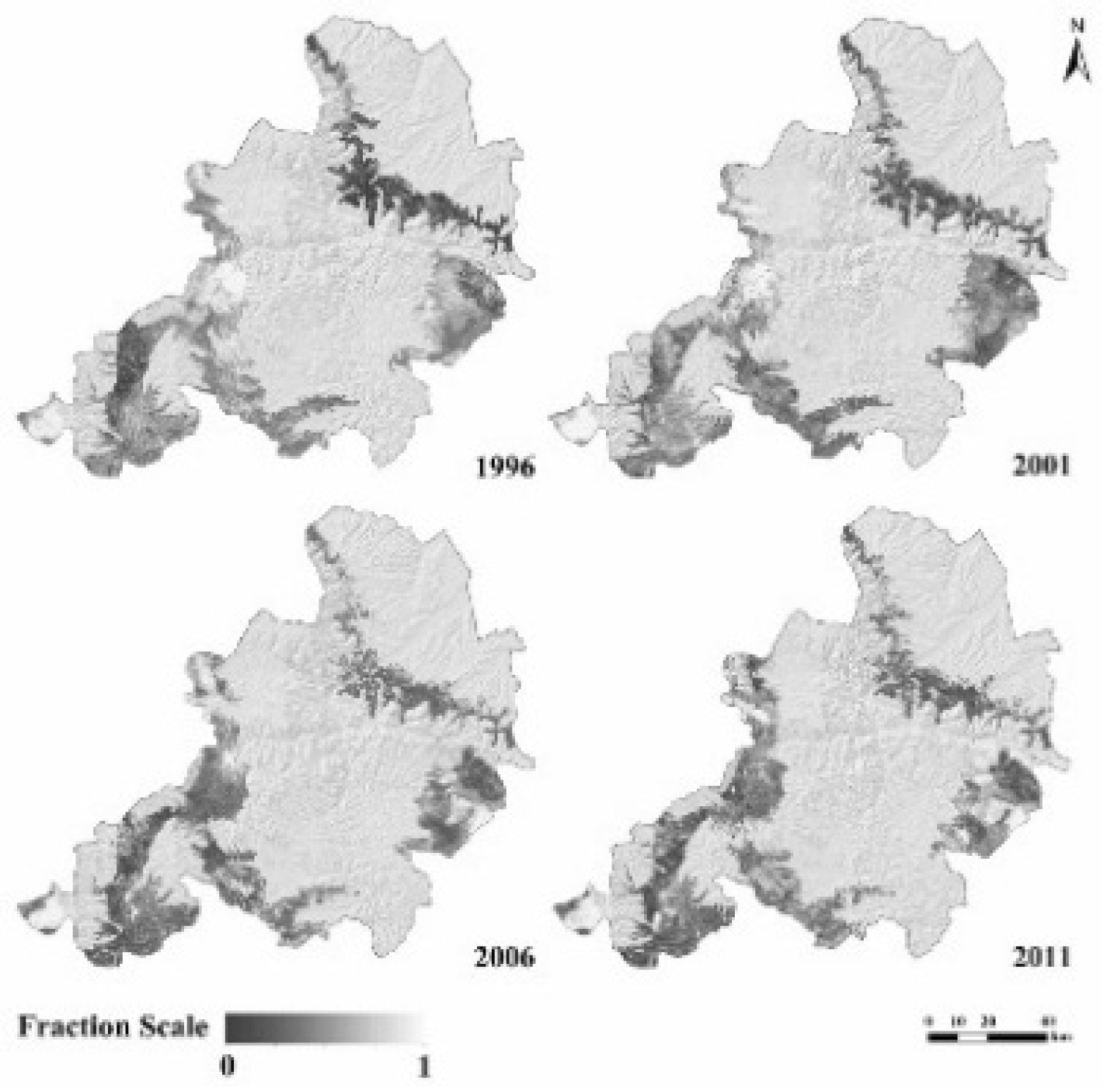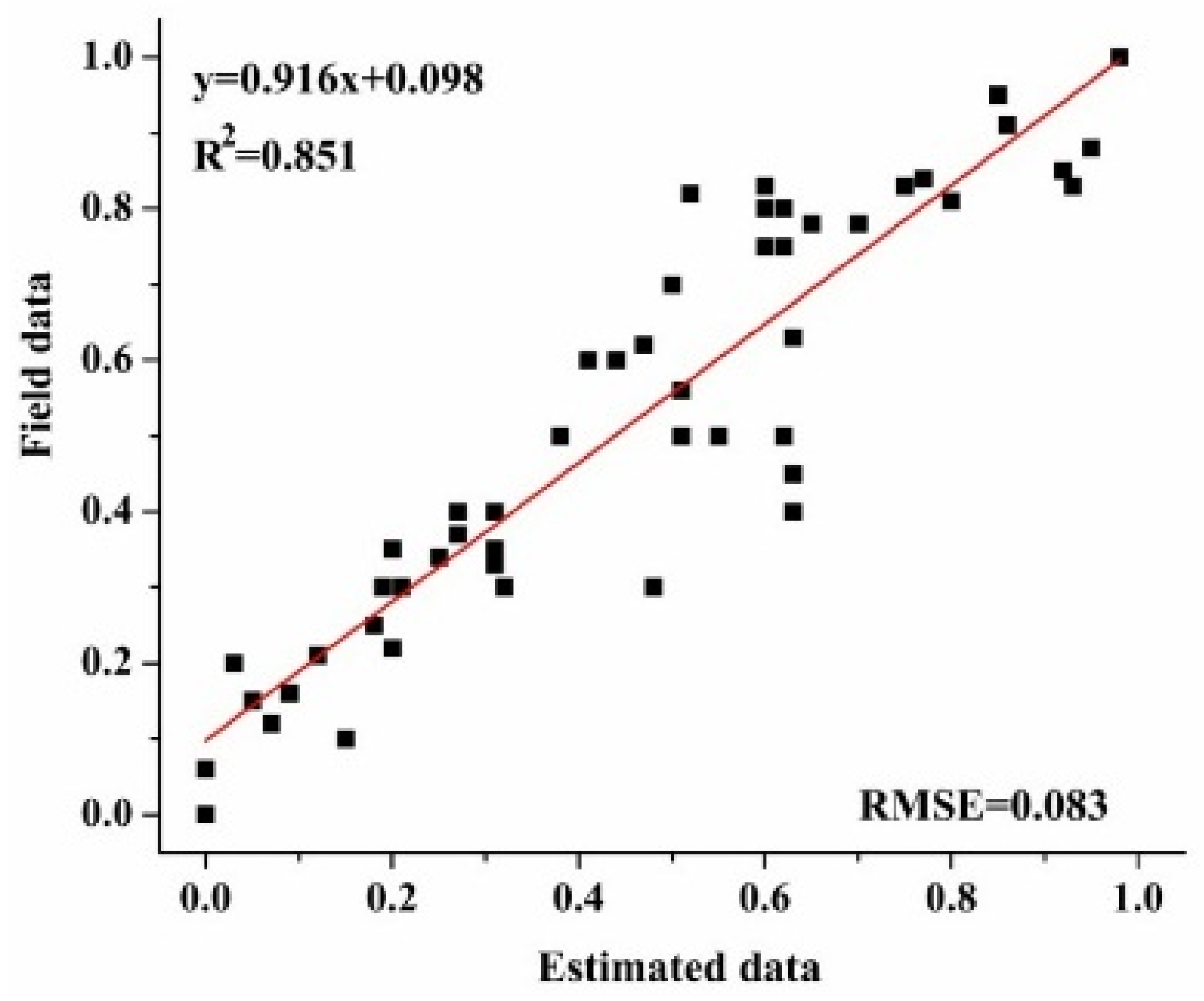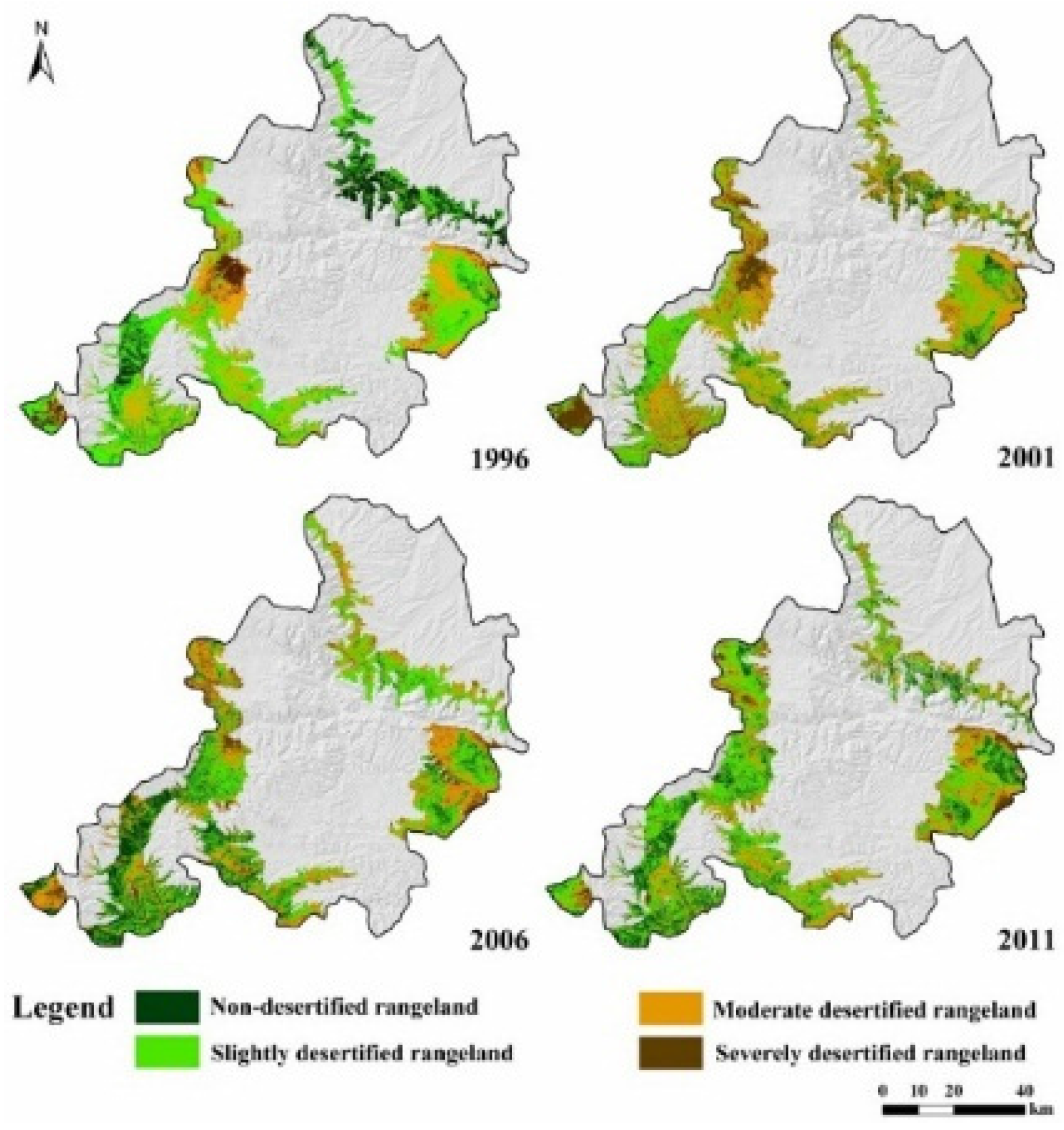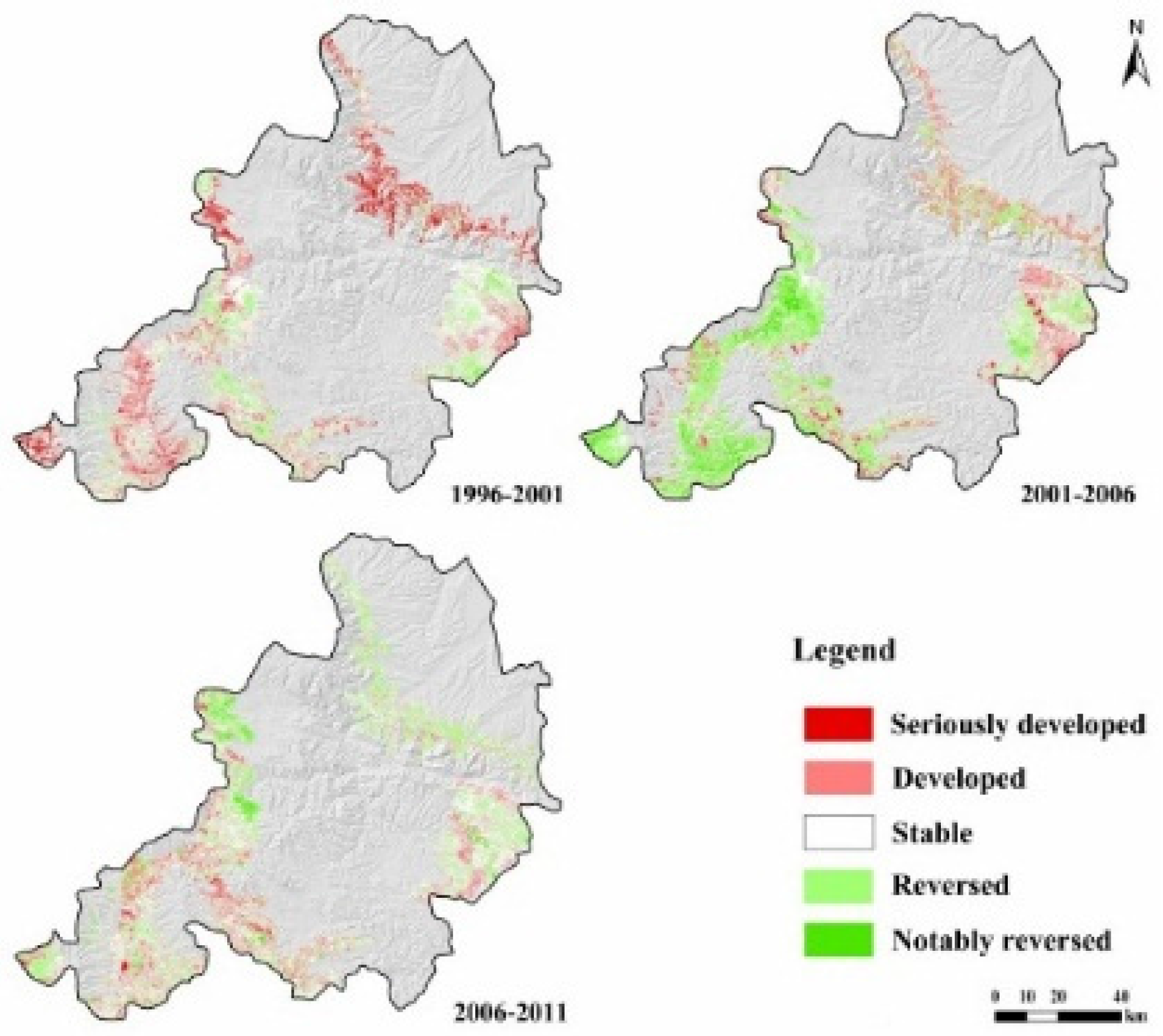3.1. Rangeland Degradation from 1996 to 2011
The results generated using the LSMA method and remotely sensed derived system of rangeland degradation (
Table 2) for the study years are shown in
Figure 5, and the individual degraded rangeland statistics are summarized in
Table 3.
In 2011, the total area of rangeland in the study region was 3619.98 km2, which increased by 17.89% compared with that of 1996. Though the rangeland area in 2001 reduced by 38.88 km2 since 1996, it extended steadily thereafter. In combining the classification maps from the four years and results of the three levels of degradation (Sl-, M-, and Se-DR) rangeland from 1996 to 2011, the total area for the three levels of degraded rangeland in 1996 was 2922.01 km2, accounting for 24.76% of the study region. During the 1996–2001 study interval, the degraded rangeland extended by 126.47 km2 relative to the area observed for 1996, Se-DR and M-DR areas increased 129.20 and 484.85 km2, an increase of 51.13% and 46.62%, respectively; conversely, the Sl-DR area reduced by 487.58 km2. However, since 2001, the degraded rangeland area decreased constantly to 2909.97 km2, resulting in a decrease of 138.51 km2 as of 2011. This may have an important correlation with the “Grain for Green” program and the grazing ban pursued by the Chinese government since 2000. During the period of 2001–2011, both Se-DR and M-DR areas showed a decreasing trend. Additionally, the Sl-DR area increased steadily to 1613.04 km2 in 2011, resulting in an increase of 471.25 km2.
The constant decreasing trend in the total degraded rangeland, Se-DR and M-DR areas, together with the steady increase in Sl-DR area from 2001 to 2011 indicate that the rangeland degradation in the study region reversed during the 2001–2011 period. After the “Grain for Green” program and grazing ban policy were implemented since 2000, rangeland vegetation was in a state of rehabilitation, and the rangeland ecosystem has achieved notable improvement.
3.2. Annual Change Rate of Degraded Rangeland
To further evaluate the change patterns of rangeland degradation, the annual change rate of degraded rangeland was obtained for the three study intervals (
Table 4).
During the 1996–2001 interval, the area of Sl-DR decreased with an annual decrease rate of 5.98%, and the annual increase rate of M-DR and Se-DR was 9.32% and 10.22%, respectively. However, the opposite situation was illustrated after 2001, namely, the area of the Sl-DR began to increase, and the annual change rates of M-DR and Se-DR turned to be negative. The increase rate of Sl-DR for 2001–2006 and 2006–2011 intervals was 3.71% and 6.38%, respectively, which means that the increase pace gradually accelerated. On the other hand, the decrease rate of M-DR and Se-DR gradually slowed down from 2001 to 2011; the annual M-DR reduction rate was 4.77% from 2001 to 2006 and 2.41% during 2006–2011; similarly, the decreasing rate of Se-DR for the two intervals was 4.58% and 0.81%, respectively. The decrease in the area of M-DR and Se-DR suggested that the “Grain for Green” and grazing ban policies implemented since 2000 in the study region played important roles in the recovery of rangeland vegetation and the reversal of the rangeland degradation trend.
3.3. Spatial Dynamics of Rangeland Degradation
Although rangeland degradation change statistics can be generated by other measures, such as census tracts, they shed little light on where the rangeland degradation changes are occurring. However, by constructing a change detection map, the advantages of remote sensing could be fully appreciated. Using raster calculation, spatial change maps of rangeland degradation were constructed (
Figure 6) for each study interval, and the elements of maps were defined as follows: (1) a one-level increase of degradation during study interval indicates “developed” (e.g., a change from Non-DR to Sl-DR); (2) a cross-level increase indicates “seriously developed” (e.g., a change from Non-DR to M-DR). Conversely, a one-level decrease indicates “reversed”; and a cross-level decrease indicates “notably reversed”. No change between two study periods was expressed as “stable” (Li et al., 2011). Meanwhile, to further evaluate the results of degraded rangeland conversions, matrices of degraded rangeland from 1996 to 2001, 2001 to 2006, and 2006 to 2011 were created (
Table 5,
Table 6 and
Table 7). Unchanged pixels in this table are located along the major diagonal of matrix and conversion values were calculated by area (km
2).
From 1996 to 2001, 532.36 and 102.19 km
2 of Sl-DR converted to M-DR and Se-DR, and 169.92 and 102.22 km
2 of M-DR changed into Sl-DR and Se-DR, respectively. The amount of Se-DR area that changed into Sl-DR and M-DR was relatively small (16.27, and 4.63 km
2, respectively) (
Table 5). Meanwhile, 176.87, 185.82, and 4.63 km
2 of Non-DR converted to Sl-DR, M-DR, and Se-DR, respectively.
In the first study interval (1996–2001), only 283.36 km
2 of degraded rangeland was either reversed or notably reversed, with the change being dispersedly distributed in the study region. Conversely, 1104.49 km
2 of rangeland was developed or notably developed, which was widely distributed in the study region. In this period, due to overgrazing and lack of effective policy guidance, the total area of developed and seriously developed degraded rangeland was 3.90 times that of the reversed and notably reversed degraded rangeland, which indicates that during the 1996–2001 interval, rangeland degradation in the study region was in a state of deterioration (
Figure 6).
In the second period (i.e., from 2001 to 2006), 283.12 km
2, 3.17 km
2, and 453.29 km
2 of Sl-DR changed to M-DR, Se-DR, and Non-DR, respectively, with the largest proportion changing to Non-DR among study periods. An area of 122.79 km
2 of M-DR changed to Se-DR, and 646.93 km
2 of M-DR changed to Sl-DR, which is 5.27 times the area that changed to Se-DR. In addition, 50.80 and 172.03 km
2 of Se-DR changed to Sl-DR and M-DR, respectively (
Table 6), which was much greater than the total area changed during the previous interval.
In this period (2001–2006), 1480.22 km
2 of degraded rangeland was reversed or notably reversed and was mainly distributed in western Xiahe County; an area of 698.28 km
2 of DR was developed in the study region (
Figure 6). The area of reversed degraded rangeland vegetation that expanded was twice the size of the area that developed and seriously developed area narrowed, showing that the implementation of “Grain for Green” program and grazing ban policies have effectively promoted vegetation rehabilitation in degraded area.
In the last study interval (2006–2011), 225.39, 9.42, and 343.24 km
2 of Sl-DR were converted to M-DR, Se-DR, and Non-DR, respectively; 87.65 km
2 of M-DR changed to Se-DR, and 408.79 km
2 of M-DR converted to Sl-DR, which is 2.35 times the change to Se-DR. Areas of 45.08 and 99.18 km
2 changed from Se-DR to Sl-DR and M-DR, respectively, which is slightly less than the area converted during the previous period (
Table 7). However, it should be noted that rangeland in Xiahe County seemed to be seriously developed, which was in contrary to the change trend of the rest study area.
From 2006 to 2011, 921.81 km
2 of DR was reversed or notably reversed, which was less than in the second period (2001–2006); the reversed area was mainly distributed in Linxia City. Meanwhile, 747.71 km
2 of degraded rangeland was developed or seriously developed, which was mainly distributed in the west of Xiahe County (
Figure 6). The area of degradation development and notable development was smaller than that of reversal and notable reversal, indicating that the rangeland in the study region was still recovering from degradation.
